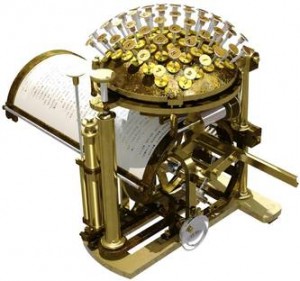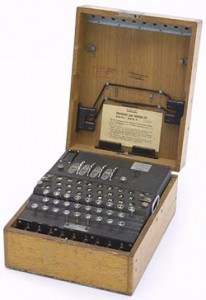The majority of the younger generations may have seen typewriters, but few have actually used them. They weren’t lucky enough to experienc the “joy” of using a typewriter eraser or liquid paper to correct those inevitable mistakes. Our new exhibit explores the fascinating history of the typewriter.
In Inventor and inventions, we learn that in 1714, Englishman Henry Mill, patented the idea of “an artificial machine or method for the impressing or transcribing of letters singly or progressively on after another.” It was proposed to take the place of slow and often illegible handwriting. Most of the early attempts, however, were actually slower than handwriting and some were as large as a piano.

There are conflicting reports about the earliest working models of the typewriter. One report says that the earliest was made in Italy by Giuseppe Pellegrino Turri, not only a nobleman, but also a skilled mechanic. He invented carbon paper to provide ink to the typewriter. Not much is known about this early typewriter, but 16 letters that were written on it are preserved in a museum in Reggio Emilia. The legend is that in the early nineteenth century he built it for his love, Countess Carolina Fantoni da Fivizzono, who had gone blind. However, another version of the legend is that the earliest typewriter was invented in 1802 by Agostino Fantoni from Fivizzano, to help his blind sister. That legend says that Turri simply improved on the machine and then invented carbon paper. We do know that in 1865 the first commercially produced typewriter was developed, and in 1870 it was patented and put into production by Rasmus Mallin-Hansen, a Danish pastor.
In 1868, Christopher Sholes and his associate Carlos Glidden secured a patent for the first commercially successful typewriter. Sholes and Glidden sold their patent to Densmore and Yost, who made an agreement with E. Remington and Sons (famous for sewing machines at that time). In 1873, Remington began production of its first typewriter. It had a QWERTY keyboard – the keyboard still in use today. The typewriter came with a foot pedal (like sewing machines) which controled the carriage returns. The QWERTY keyboard was developed to slow typists down. The most often used letters were spaced far apart and the slower speed helped correct the problem of jamming. The Remington No. 2 typewriter was introduced in 1878 and it came with the option of upper and lower case letters.

A stenotype was patented in 1895 and is a special shorthand machine that is used not only in court reporting, but also in closed captioning. The trained stenographer must be able to type at speeds up to 225 words per minute with a high degree of accuracy.
A patent for an electric typewriter was filed by Thomas Edison in 1872, but the first workable model didn’t come out until the 1920s. Typewriters continued to improve and develop, moving from the early electric typewriters to the more modern “IBM Selectric” typewriter which used a ball rather than the earlier type bars. There was also the “daisy wheel” – a disk with the letters and numbers stamped on the outer edges. From there the typewriter evolved into the electronic typewriter which had a memory where text could be stored.

The earliest known military ciphering tool, the Scytale, was used more than 2500 years ago. A messenger wore a belt – a stretch of leather- which had characters written on it. They were seemingly random and could only be deciphered when the leather was wrapped around the correct size piece of wood. There is a replica of a Scytale in our exhibit – stop by and see if you can decipher the message!

Cryptography and ciphering have gone through many transformations since the Scytale. At the end of World War I, German engineer Arthur Scherbius invented Enigma – an electro-mechanical rotor cipher machine. It was adopted by the military of several countries, most notably Nazi Germany. When it was first developed, the cipher was changed every few months which meant the codes were often cracked. However, when World War II broke out, the code was changed on a daily basis, making it nearly impossible to break. In 1940, codebreakers at Bletchley Park broke the code. They had created machines, called ‘bombes,’ which cracked the ‘Green Key’ – the administrative key for the German Army, and then they managed to crack the ‘Red Key,’ – used by Luftwaffe liaison officers coordinating air support for army units. It is said that breaking these codes shortened the war by at least 2 years. The Colossus, created by Alan Turing, was built to break another German encryption machine called the Lorenz cipher. The Colossus is the precursor to the modern computer.
There are three typewriters in our exhibit – dating from the early 1900s to the 1960s. We have both an Underwood #5 and a Remington Noiseless from the 30s and a Smith Corona Coronet from the 50s-60s. The Smith Corona is interesting because it is electric, but still has a manual carriage return. There are several photographs from the 1950s showing women in Jessup Hall using typewriters. Come see the typing pool and what were probably state-of-the-art typewriters. Thank you to the Department of Special Collections and University Archives for providing copies of these photographs. The photos are part of the F.W. Kent Collection of Photographs. Thanks also, goes to Lindsay Vella for graciously lending her typewriters for this exhibit!
Fun Facts:
Just for fun!
The Typewriter. Composed by Leroy Anderson, October 9, 1950. Performed June 12, 2011 by Voces para la Paz; soloist: Alfredo Anaya.
- Fastest Typist in the World is Barbara Blackburn. Her top speed was recorded at 212 words per minute. She appeared on the David Letterman Show in 1985.
- Mohammed Khurshid Hussain set the World’s Record for Fastest Nose Typing.
- A QWERTY keyboard takes 15 keystrokes to type “court reporting.” A court reporter using the Stenograph keyboard takes 3 keystrokes.
- Earliest known cryptography is found in the non-standard hieroglyphs carved into monuments in ancient Egypt – as far back as 1900 BC.
- Court reporters do not listen or type words or listen for context – they only use phonetics.
- George K. Anderson of Memphis, TN, patented the typewriter ribbon on 9/14/1886.
- Every typewriter has its own individual pattern of type – like a fingerprint. Special forensic agents were used in police departments to identify typewriters used in blackmail and other criminal activities.
- Mark Twain was the first author to submit a typewritten manuscript to his publisher.
- Keyboard fashion fun!



Resources:
McCorquodale, Duncan, editor. 2009. Inventors and inventions. London : Black Dog Engineering Library FOLIO T48 .K58 2009
Computer keyboard. 2015. History of Computers.
Langone, John. The new how things work: everyday technology explained. 2004. Washington, D.C. : National Geographic Society. Engineering Library FOLIO T47 .L2923 2004
Scytale. 2014. Cryptool-Online.
Breaking Enigma. 2015. Bletchley Park.
Was the first computer a ‘Bombe’? Computer Science for Fun. Queen Mary, University of London. Date accessed: July 1, 2015.
Other Resources:
History of Smith Corona. 2015. Smith Corona Corporation.
A brief history of typewriters. The Classic Typewriter Page. Dated accessed: July 6, 2015.
History of the computer keyboard. 2015. About Money. About.com
Typewriters. 2015. About Money. About.com